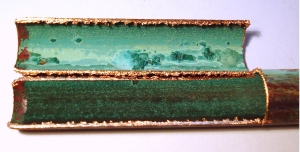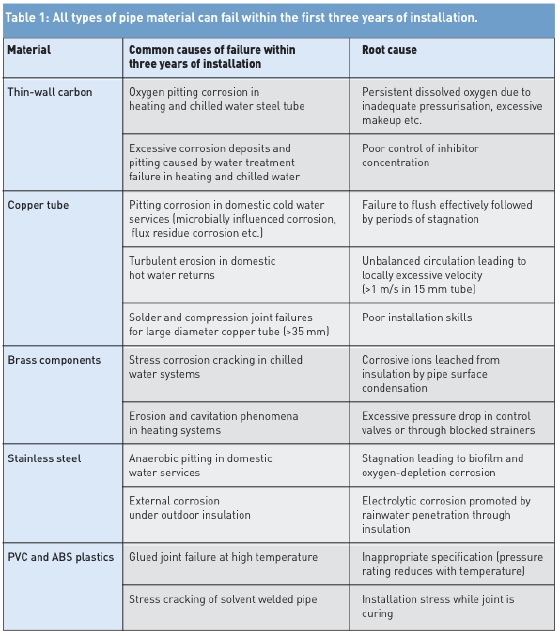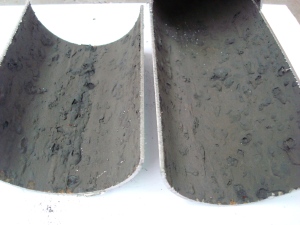Life secrets

Pipework systems that survive for three years should be good for many more years after that time. Reginald Brown of BSRIA highlights the problems that occur and offers advice on how to avoid them.
The primary function of a pipe is to transport fluid between two points — without losing any on the way or fostering contamination. If that fluid is water at modest temperature and pressure, there are numerous possible pipework materials and jointing systems. In principle some of these can function reliably for hundreds of years — but none is without risk of developing problems if the design, installation and operational constraints are not properly considered. In the worst cases the problems can become painfully apparent even before the installer has left site.
 |
| Cold-water pitting leading to perforation of 15 mm copper tube from a cold-water system. |
CIBSE guides suggest that pipework installations for heating and cooling in buildings should have an economic life of 25 to 30 years. However, that may be more to do with the anticipated refurbishment cycles of commercial buildings than the material characteristics of pipework and fittings. After all, many of us live in mid-20th century housing with the original heating and hot water pipework showing no sign of imminent failure. If it was possible to construct reliable plumbing in the 1950s why can’t we do that now?
The answer is that we can and do produce reliable plumbing for most buildings, most of the time. In fact modern methods of working mean the hydraulic integrity of the as-installed systems prior to pressure testing is probably far better than it was in 1950. The issue of concern is the number of high-profile buildings that suffer early corrosion problems or other material defects that lead to failures within three years of installation.
Common causes of early failure based on samples submitted to BSRIA are listed in the table (below), though no system is immune to failure in a poorly installed or badly maintained system.
 |
If we discount the avoidable design, specification, installation, commissioning and maintenance issues, the residual problems are often associated with stagnation — that is the absence of flow. This applies to both domestic water services and closed heating and cooling systems, though the issues are slightly different.
For domestic water services installed in copper tube, if the building can be put into use within a few days after the pipework systems are first filled, any remaining construction or disinfection residues will be rapidly flushed away before they can do any damage, and a protective patina of copper carbonate will naturally form on the inner surface of the pipe. This patina reduces the risk of sporadic biofilm development leading to microbially influenced corrosion (MIC) of bare copper tube. Private houses have short construction programmes and tend to be occupied as soon as complete. Unfortunately this is not the case for public and commercial buildings; they have much longer construction programmes and progressive occupancy after handover. The best corrosion protection for a domestic water system is to use it.
 |
| Severe corrosion and under-deposit pitting of 67 mm thin-wall steel tube from a heating system |
Plastic pipework does not suffer from metallic corrosion, but stagnation will encourage the development of biofilms that may adversely affect water quality and increase the risk of colonisation of the system by legionella and other bacteria. Note that chlorination will kill surface bacteria but may not completely penetrate and remove established biofilm, so it is preferable to avoid it forming in the first place.
For closed heating and cooling systems, there is usually a period of stagnation between filling and commissioning. This allows the development of biofilm that will influence subsequent corrosion, particularly of steel pipework and steel components, even after the system is cleaned. Application of a suitable biocide and monitoring programme between filling and pre-commission cleaning, as described in ‘BSRIA guide to pre-commission cleaning of pipework systems’ (BG 29/2012), should reduce that risk, but minimising the stagnation period is better. Once the systems are cleaned and commissioned, careful attention should be given to maintaining an effective water-treatment regime, reduction of dissolved oxygen supported by periodic circulation, and cycling of control valves to ensure that all parts of the system are continually exposed to corrosion inhibitors irrespective of heating or cooling demand.
The mantra for reducing the risk of failure in pipework systems should be ‘keep the fluid moving, but not too fast’. If your domestic water, heating or chilled water pipework system has already survived its first three years without problems then, subject to a reasonable standard of maintenance, it probably is good for the next 25 years.
Reginald Brown is head of energy and environment at BSRIA.







